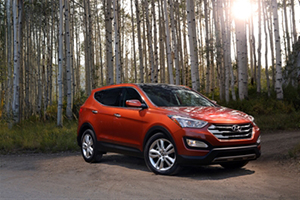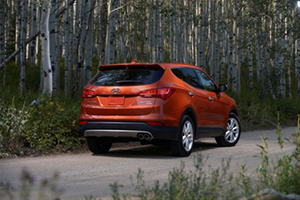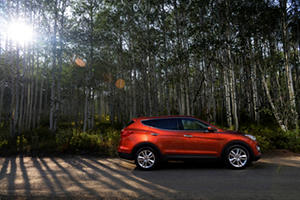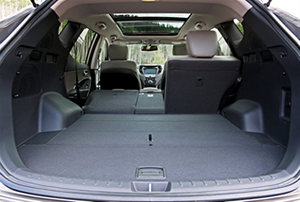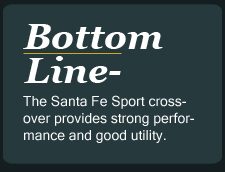2013 Hyundai Santa Fe Sport
Redesigned
2013 Hyundai Santa Fe Sport crossover has sleeker styling.
Prices - $24,450-$29,450
The mid-size 2013 Santa Fe Sport crossover has rakish new styling
similar to that of Hyundai Sonata and Elantra sedans. It also has
carlike road manners and plenty of room.
The Santa Fe Sport should do well, even though it’s up
against rivals such as the Honda Pilot, Chevrolet Equinox, Ford Edge,
Nissan Murano and Toyota Highlander.
The five-passenger two-row Santa Fe Sport should not be confused with
the costlier, longer-wheelbase seven-passenger, three-row Santa Fe,
which has replaced Hyundai’s underachieving 7-passenger
Veracruz. That Santa Fe lacks the word “Sport” in
its name, but comes with a 3.3-liter, 290-horsepower V-6.
The solidly built Santa Fe Sport lists from $24,450 to $29,450 and
comes with either front- or all-wheel drive (AWD). It weighs 3,459 to
3,706 pounds, depending on the drive system.
You can’t get the Sport with the longer Santa Fe’s
V-6. Rather, power comes from a 2.4-liter, 190-horsepower four-cylinder
or a turbocharged, direct injection 2-liter four-cylinder with 264
horsepower.
Both engines work with a responsive six-speed automatic transmission.
I recommend the turbo engine. It reminded me of the Volkswagen/Audi
turbo 2-liter in that it operated smoothly, provided fast acceleration
and acted like a larger engine.
Estimated fuel economy of the 190-horsepower engine with
front-drive is 21 miles per gallon in the city and 29 on highways, or
20 and 26 with all-wheel drive. Figures for the turbo engine with
front-drive are 20 city and 27 highway—and 19 and 24 with
with all-wheel drive.
I tested Hyundai’s $27,700 higher-line Sport 2.0T model with
the turbo engine and front-wheel drive and found it to be carlike
and—typical of Hyundais—packed with a good amount
of standard equipment.
Standard items for the 2.0T include heated front seats, power
driver’s seat, proximity key entry with pushbutton start,
automatic headlight control, AM/FM/MP3 sound system,
steering-wheel-mounted cruise, audio and phone controls,
electroluminescent gauge cluster and split-folding rear seatbacks.
There also are a sporty chrome twin-tip exhaust and front fog lights,
besides 19-inch silver alloy wheels.
There also are stability and traction controls, a vehicle stability
management feature, anti-lock brakes with brake-force assist and
distribution, downhill and hillstart assist controls—along
with the usual airbags, including a driver’s knee bag.
Rear visibility through the back window is poor. Large outside mirrors
help. But, if you’ve got the bucks, I’d recommend
the optional rearview camera, which comes in a $2,450 option package
that also contains leather seating surfaces, power front passenger
seat, heated rear seats, dual-automatic temperature control and an
easily read 4.3-inch color audio display.
A $2,900 “technology package” has a panoramic
sunroof with tilt-and-slide features, navigation system with an 8-inch
touchscreen, upscale audio system and a heated steering wheel, which
was a blessing during cold Chicago winter days.
Too bad for your bank account that the optional packages must be
ordered to get the rearview camera, sunroof, power front passenger
seat, upscale audio and navigaton systems and the heated wheel. But
Hyundai isn’t the only automaker to put desirable items in
fairly expensive “option packages.” Some just put
them in higher-scale models.
My test Sport’s automatic transmission had an easily used
manual shift feature. The quick steering felt somewhat numb, but the
Sport tracked well at highway speeds, which will help make it a good
long-distance interstate cruiser.
The ride was rather firm, but supple, and handling was pretty
good for a 66.1-inch-high vehicle in which occupants sit high. The
brake pedal had a nice progressive action.
The driver’s seat in the quiet interior has decent side
support during spirited driving and is comfortable, as are the
Sport’s other seats. However, the center of the backseat is
too stiff for comfort.
Climate controls are large, and sound system controls are easy to use,
as are the optional front-seat heat controls. The console has nicely
placed dual front cupholders and a deep covered storage bin. Large
front door pockets contribute to interior storage. There’s a
good amount of interior plastic, but it doesn’t look cheap.
The opening for the large cargo area is low and wide, and rear
seatbacks easily flip forward for more cargo room, with a large
pass-through area from the regular cargo area to the rear-seat area.
The hatch opens smoothly on hydraulic struts and has a handy, hefty
interior pull-down bar.
The hood has an interior lining for sound control and smoothly swings
up via twin struts to reveal a surgically neat engine compartment.
The Sport has Hyundai’s 10-year/100,000-mile powertrain
warranty, which helped save its reputation years ago, and a
5-year/60,000-mile new vehicle warranty.
“Good styling sells,” as the saying goes. So the
Santa Fe Sport’s new styling and features should help attract
a larger number of buyers and further increase Hyundai’s
already impressive U.S. sales.
